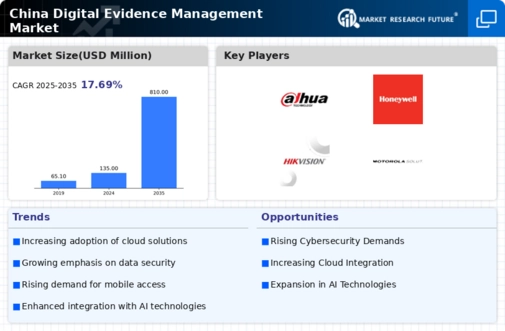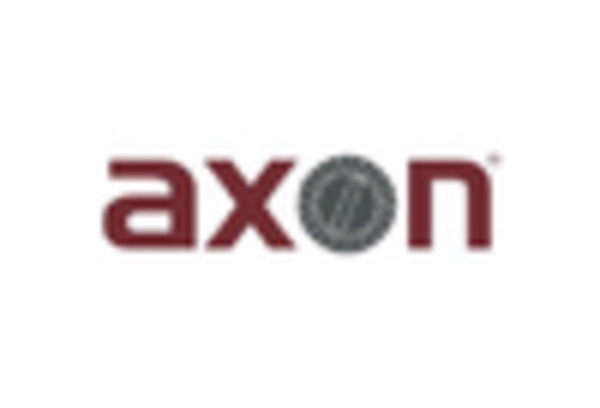Emergence of Smart Cities
The development of smart cities in China is driving the demand for digital evidence-management solutions. As urban areas become increasingly interconnected through IoT devices and smart technologies, the volume of digital evidence generated is expected to rise significantly. By 2025, it is projected that smart city initiatives will encompass over 500 cities across China, leading to a surge in data collection from various sources, including surveillance cameras and traffic monitoring systems. This influx of data necessitates robust digital evidence-management systems capable of efficiently processing and analyzing information. As municipalities seek to enhance public safety and streamline law enforcement operations, the digital evidence-management market is likely to experience substantial growth, fueled by the integration of smart technologies.
Rising Cybersecurity Threats
The surge in cybersecurity threats in China is a significant driver for the digital evidence-management market. As organizations face increasing risks from cyberattacks, the need for effective digital evidence-management solutions becomes paramount. In 2025, it is estimated that cybercrime could cost the Chinese economy over ¥1 trillion, highlighting the urgency for businesses and government entities to adopt comprehensive digital evidence-management strategies. These strategies not only aid in the identification and mitigation of threats but also ensure that digital evidence is preserved for potential legal actions. Consequently, organizations are investing in advanced digital evidence-management systems that enhance their ability to respond to incidents and protect sensitive information, thereby propelling market growth.
Focus on Data Privacy Regulations
The emphasis on data privacy regulations in China is emerging as a critical driver for the digital evidence-management market. With the implementation of stricter data protection laws, organizations are compelled to adopt solutions that ensure compliance while managing digital evidence. The Personal Information Protection Law (PIPL), enacted in 2021, mandates organizations to handle personal data responsibly, which directly impacts how digital evidence is collected and stored. As businesses and government agencies strive to align with these regulations, the demand for digital evidence-management systems that incorporate privacy features is likely to increase. This focus on compliance not only enhances the integrity of digital evidence but also fosters trust among stakeholders, thereby contributing to the overall growth of the market.
Growing Demand for Digital Forensics
The increasing need for digital forensics in law enforcement agencies is a primary driver for the digital evidence-management market. As cybercrime rates escalate, authorities in China are compelled to adopt advanced digital evidence-management solutions to effectively investigate and prosecute criminal activities. The market is projected to grow at a CAGR of approximately 15% over the next five years, reflecting the urgency for robust digital forensics capabilities. This growth is fueled by the necessity to manage and analyze vast amounts of digital data generated from various sources, including mobile devices and social media. Consequently, law enforcement agencies are investing in sophisticated tools that enhance their ability to collect, preserve, and analyze digital evidence, thereby ensuring the integrity of investigations and legal proceedings.
Increased Investment in Law Enforcement Technology
The Chinese government is significantly increasing its investment in law enforcement technology, which serves as a crucial driver for the digital evidence-management market. With a focus on modernizing police forces and enhancing public safety, funding for advanced technologies is on the rise. In 2025, the budget allocation for law enforcement technology is expected to exceed ¥100 billion, indicating a strong commitment to improving investigative capabilities. This financial support enables law enforcement agencies to procure state-of-the-art digital evidence-management systems that streamline the collection, storage, and analysis of digital evidence. As a result, the market is likely to witness substantial growth, driven by the demand for efficient and effective solutions that can handle the complexities of modern crime.

















Leave a Comment